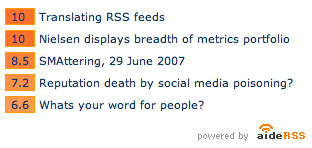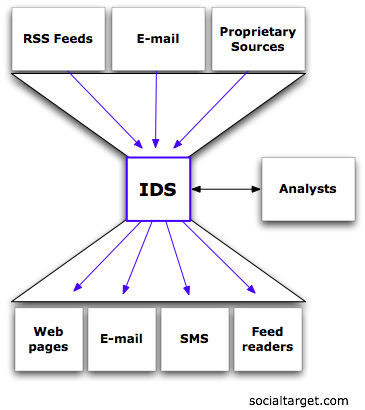 AideRSS is a new RSS-filtering service designed to help people manage the volume of posts in their subscriptions. It uses a proprietary PostRank metric to group posts from a given feed into Good/Great/Best groups and creates a filtered RSS feed for each. For readers, this has the potential to be a big time-saver. For publishers, it further complicates the RSS metrics situation while creating a handy overview of online reactions to posts.
AideRSS is a new RSS-filtering service designed to help people manage the volume of posts in their subscriptions. It uses a proprietary PostRank metric to group posts from a given feed into Good/Great/Best groups and creates a filtered RSS feed for each. For readers, this has the potential to be a big time-saver. For publishers, it further complicates the RSS metrics situation while creating a handy overview of online reactions to posts.
Complicating RSS metrics
RSS audience metrics are tricky already. The conventional wisdom recommends the use of Feedburner, largely for its feed analytics. Feedburner stats are a big help, but they miss indirect subscribers to the feed. For example, content that is republished on another site (such as selections from this blog that appear on Social Media Today) may be available in feeds from that site; subscribers to those feeds don't show up in the stats.
AideRSS potentially creates a new pool of readers who don't show up in Feedburner stats. Even if AideRSS were to report subscriber numbers to Feedburner, like Bloglines or Google Reader, the numbers wouldn't add up—readers of a filtered feed aren't the same as readers of the full feed. So the new service complicates RSS stats in proportion to its popularity.
Tools for publishers
It's not all headache, though. AideRSS has two features of immediate interest to publishers: a PostRank widget to help visitors find your "best" posts, and a reporting interface with real potential.
 The widget looks interesting, and since I'm in the middle of customizing my blog design (thanks for not pointing out the obvious deficiency), I might even use it.
The widget looks interesting, and since I'm in the middle of customizing my blog design (thanks for not pointing out the obvious deficiency), I might even use it.
The really interesting thing for publishers is the overview page AideRSS creates for each site. Like everything in the first release, it's meant for readers, with its links to the filtered posts, but look at the information it collects about each post in the feed (with links to the appropriate sources):
- Number of comments
- Links via Bloglines, Technorati and IceRocket
- del.icio.us bookmarks
That last one is big; tracking
del.icio.us is a pain (almost as much as typing del.icio.us). If AideRSS were to go one more step and add feeds for the analytics, it would be a must-have tool for publishers—at least until del.icio.us provides a domain search feature. Published stats from AideRSS would partially address the earlier analytics problem, too. If the service becomes popular, it opens the door to a new kind of audience segmentation (by selected filter).
Publisher services—someday
While the initial service—and all the publicity— focus on the free subscriber service, AideRSS realizes the potential value to publishers in their system. Chief Architect Ilya Grigorik talked with Josh Catone about potential publisher services:
Ilya told me that as the index grows, there exists the potential for meaningful analysis of post and reader trends, patterns, habits, meme tracking, etc. These sort of services are the type of things that could potentially be offered on a for-pay basis to publishers, but Ilya stressed that that is not a focus for AideRSS at the moment.
While we're waiting for the real deal, I'll be using AideRSS to track del.icio.us and see what an objective observer thinks of my posts. I may even use it to get a handle on the flood of posts in my reader.
Tags: AideRSS rss analytics del.icio.us
 IDS was to be an RSS-based system for aggregating and redistributing market intelligence, including analyst research subscriptions, inside the corporate firewall. Existing access methods required logging into and searching each analyst firms's web site individually, which meant that many individuals with paid access to the research don't bother finding it. IDS would provide more efficient access to help companies extract more value from that research.
IDS was to be an RSS-based system for aggregating and redistributing market intelligence, including analyst research subscriptions, inside the corporate firewall. Existing access methods required logging into and searching each analyst firms's web site individually, which meant that many individuals with paid access to the research don't bother finding it. IDS would provide more efficient access to help companies extract more value from that research.
 The widget looks interesting, and since I'm in the middle of customizing my blog design (thanks for not pointing out the obvious deficiency), I might even use it.
The widget looks interesting, and since I'm in the middle of customizing my blog design (thanks for not pointing out the obvious deficiency), I might even use it.